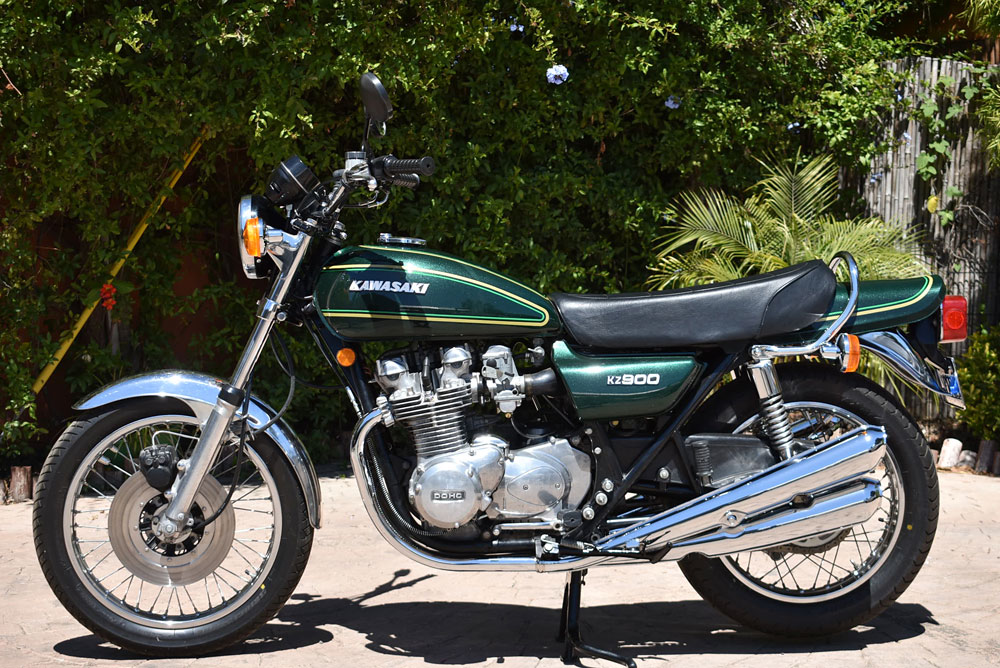When introduced late in 1972, the Kawasaki Z1 900 was the largest and most powerful 4-cylinder 4-stroke Japanese motorcycle ever built.
Sensibly Restored:
1976 Kawasaki KZ900
Please wait a few moments while the high-resolution photos load.

Mouse Over the Photos to Enlarge.
Absolutely groundbraking in many ways, with looks to die for and a heart-stopping performance to boot, the Z900 has become a legend of the motorcycle world. It is one of the most collectible Kawasakis of all time and has become a solid investment that will continue to increase in value as time moves on.

Built only for four short years -- as the Z1 for '73, the Z1A for '74, the Z1B for '75, and the Z900 for '76 -- many congescenti argue that the last of those 900s are actually the best, as by late '75 the issues with carburetion stumbling and the overretarding automatic ignition advance mechanism had been solved, making riding the bike much more enjoyable.

This particular bike, VIN *Z1F-116690*, was built in July of 1976. It is among the last batch of Z900s ever made. It is unmolsted, bone stock, and 100% matching numbers.


Purchased from the original owner on September 7, 1978, the second owner kept the bike for 36 years. In 1986, by then too old to ride, he hung up his helmet for good, and parked the all-original bike in his garage, with only 9,394 miles on the clock. It would remain in hibernation until I found and purchased it from his widow, on June 4, 2015.

The bike came with the Certificate of Title issued on October 26, 1978, and the original license plate, issued in Wyoming back in '76.

I had the bike shipped to Kawasaki specialist Americanclassix near Palm Springs, California. Propriator Axel, an old friend of mine, had kindly agreed to restore the bike, sensibly, as needed, at the same time trying to keep it as original as possible.


The restoration would take two more years and cost another $3,106.00 in parts, and $2,255.00 in labor. All said and done, I have invested $11,059.84 in the bike, fully documented.

The mileage shown on the odometer, 9,434, is the total mileage this bike has traveled in the past 4 decades. Although there's some paint fading on the gauge faces and some spotting on the glass, I opted not to touch these instruments, for obvious reasons.

Today the Z presents itself crisp, sparkling, throroughly fresh yet with an aura of originality, that would be hard to duplicate. It starts on the button and immediately falls into a steady idle. The bike is an absolute joy to ride and takes me back to 1977, when I was a young lad and had an identical bike. As a 20-year-old, I almost killed myself riding it full out. Now 60 years old, I'm a lot smarter.

This Z is bone stock, save for the -- brand new -- Bridgestone Battlax BT45 tires, that provide a great deal more grip than the Bridgestones that were available 40 years ago.

The 903cc engine features chain-driven twin overhead cams, a HEMI head, and flat-top pistons. Compression ratio is a reasonable 8.5:1. Due to sintered-alloy exhaust valve seats, the engine was designed from the get-go to run on lead-free gas. Carburetion is provided by four 28mm Mikunis. The engine produces 82 horsepower at 8,500rpm.

Compression is a superb 120 to 130 on all four cyclinders. Carburetors have been rebuilt. Air box is new. There are no leaks of any kind.

Let's now have a closer look at the different components, shall we?

Both wheels are original Kawasaki, with original chrome and original cad-plated spokes and nipples. The chrome is in excellent condition throughout. Tires are new. Fork legs are original, with new fork seals and dust boots installed. Original front fender has been rechromed.

With the exception of the gauges themselves, everything you see here was taken apart, cleaned, rebuilt, or replaced. Clutch lever, clutch cable, steering head bearings, ignition lock, brake fluid reservoir, switch pod, clutch lever, clutch cable, and both mirrors are new.
I also have the original hazard flasher switch, but I opted not to have it re-installed, as it really has no practical purpose.

Paint is the correct Kawasaki Green Urethane, a 3-piece paint kit that requires compentent mixture of the metal flakes. It was purchased from Kawasaki specialist Paintworkz. Stripe kit originates from Z1 Parts. The entire paint set was masterfully finished by The Hired Gun, a top-notch motorcycle paint artist with many awards under his belt. All of this came at a price: exactly $810.00 went into refurbishment of tank, side panels, and tailpiece. Money well spent.

Original seat pan was just too well preserved to mess with it. Even the labels were suberbly preserved. All it received was a good detailing, new foam, and a new cover.

The grab rail is an original and in fantastic condition. The reproduction rails have a wrong arch, so that's a no-go for any serious restoration.

Bone stock underseat area. Note factory labels on frame and seat pan. New battery, air box, air filer, seat lock.

Fabulous and scary expensive four-into-four exhaust system is brand new, with zero miles on it.

This was a lovely, all original, super low mileage bike when I bought it. Yet it took another two years and $7,620 to bring everything up to snuff, and that was with business connections and heavily discounted parts prices. Doing it right without taking shortcuts doesn't come cheap.

It's been over 4 decades since this bike has been manufactured, but it has lost none of its aura. A truely timeless classic!